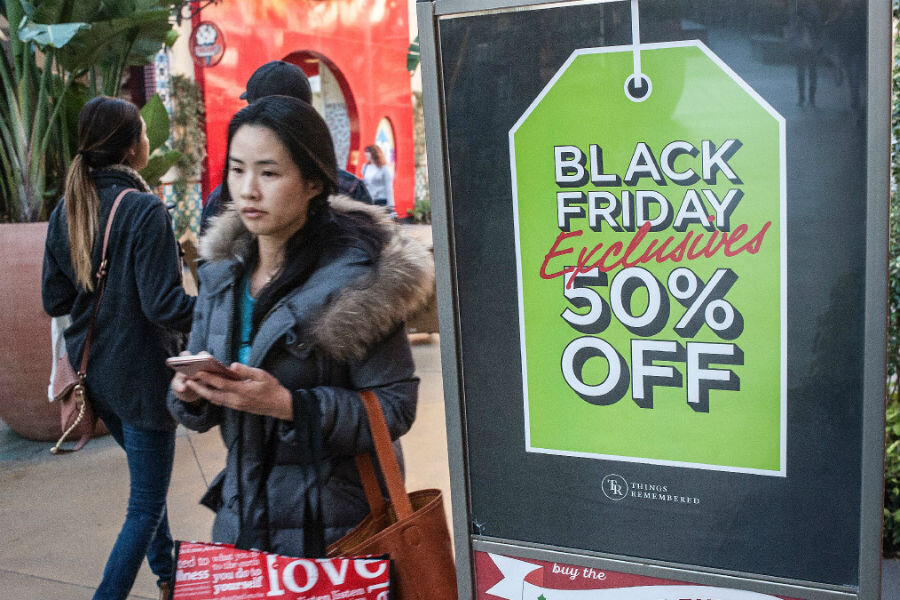Was that the end of Black Friday as we know it?
Loading...
Lines were a little shorter, stores a little less crowded, and early-morning stampedes a little quieter this Black Friday, as more Americans opted to snag post-Thanksgiving deals from the comfort of their own laptop or smartphone.
Net sales in brick-and-mortar stores on Thanksgiving and Black Friday fell by 5 percent this year, with sales in brick-and-mortar chain stores experiencing a 10.4 percent decline. Meanwhile, online sales rose in the double digits on both days, continuing a shift away from the typical in-store madness that Black Friday has come to be known for and toward a shopping experience spread out over several days and split between brick-and-mortar stores and the internet.
"We recognize the Thanksgiving weekend shopping experience is much different than it used to be as just as many people want that unique, exclusive online deal as they do that in-store promotion," said National Retail Federation president and chief executive Matthew Shay in a press release about 2015 Black Friday sales results. "It is clear that the age-old holiday tradition of heading out to stores with family and friends is now equally matched in the new tradition of looking online for holiday savings opportunities."
Black Friday 2016 was perhaps the most extreme demonstration of just how much the day has changed.
"I’ve been doing this for 40 years, and I’ve never seen a Friday morning be this quiet," said Marshal Cohen, chief industry analyst at NPD Group, to Bloomberg.
As more stores offer deals in the days before and after Black Friday and more consumers choose to peruse store offerings online rather than taking a chance at their local Wal-Mart, Black Friday is beginning to look very different, industry experts say.
"As big as the event or the weekend has become, it’s substantially muted for the fact that all of the people are buying online," Mark A. Cohen, director of retail studies at Columbia Business School, told The New York Times.
Some of the decrease in brick-and-mortar turnout on Friday can be attributed to more stores getting a head start on deals.
"For the last few years, there’s been an extension of the Black Friday online shopping behavior," Tony Zito, chief executive officer of Rakuten Marketing, told Bloomberg. "It moved aggressively into Thanksgiving, and now it’s gone into Wednesday."
There's also been a broader shift toward online holiday shopping, driven largely by millennials, as The New York Times reported last week:
Young people of all kinds, a coveted group for retailers because of their typically larger discretionary income, are increasingly turning to their computers and phones to do their holiday shopping, spreading out more widely the days they open their wallets. Crowds on Friday, the unofficial kickoff of the holiday shopping season, will tilt older than a few years ago, and also, it appears, more cautious with their money.
As a result, the mix of retailers with high expectations for the day is changing quickly, skewing more toward dollar stores and discount retailers and toward essential products like food and cookware. And it is also making the day itself less and less important for the industry over all.
As Black Friday becomes an increasingly-online event, the relevancy of Cyber Monday, Friday's cooler younger cousin, has come into question.
"Black Friday may have just dethroned Cyber Monday’s position as largest online shopping day of the year," Tamara Gaffney, principal analyst and director of Adobe Digital Insights, predicted to MarketWatch on Saturday.
For some consumers who chose to stay away from brick-and-mortar stores on the day after Thanksgiving, the sheer scale of the hype that's traditionally surrounded the shopping holiday was enough to drive them online.
Twenty-four-year-old James Seatter of Houston, Tex., said he used to regularly visit stores on Black Friday with his family. This year, he opted to make his purchases on the internet "because of the crazies."
"I don’t want to fight with someone over a toaster oven at Wal-Mart," he explained to The Wall Street Journal. "It’s just easier to do it online, on my time so I don’t have to fight the crowds."








